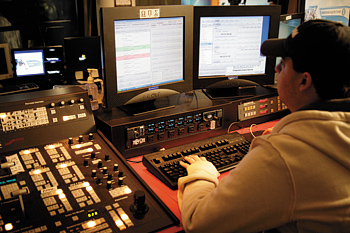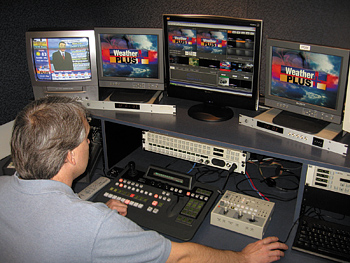Economy, Efficiency Drive IPS Advances
DALLAS
An "integrated production system" once meant something that fit the building without busting walls and didn't blow fuses when powered-up. Today's IPS configurations are often car-trunk sized, yet pack an 18-wheeler's worth of creative goodies. They're riding the convergence wave and helping traditional broadcasters weather the economy.
ADAPTING WORKFLOWS
Thomson Grass Valley's Ignite control room automation solution is used primarily in news, "but these same workflows can be adapted to other applications and market segments," said product manager John Benson.
Combined with MediaFUSE, a toolkit for simultaneous Web, mobile, and IPTV platforms, Ignite "provides a workflow that allows programs to be cost effectively created and distributed over-the-air, while providing timely content for Web and mobile," Benson added.

Damien Spellman, a studio operator with MLB.com, operates a Ross Overdrive system. ©Jana Crawford Ignite was designed for large market operations, according to Alex Holtz, director, integrated production solutions. "We took into account the high volume, complexity, and extremely dynamic nature of newscasts," he said.
More than 100 deployed systems are evenly spread among upper and lower-tier markets, per company data. "The installed base is predominately news, but stations also use it for productions, such as entertainment, interviews, telethons, shopping, election coverage, promo/commercial creation and sports," said Benson.
While versatility is an important element in designing an integrated production system, price is just as—if not more—important these days.
Economic issues were a factor when Ross Video launched Over-Drive in 2004. Stations were concerned with "being competitive and making a profit; the last couple of months really put it on the front burner," said Brad Rochon, marketing product manager. "OverDrive is driven by two forces: Reducing staff and improving production quality. Our approach was 'you can do a production with fewer people in the room...' we focused on doing more productions, cleaner, and with fewer mistakes, and on handling changes where most mistakes happen: breaking news, on-the-fly coverage, unscripted events... that was a really big differentiator."
Like Ignite, OverDrive's ongoing focus is to use technology to manage live production, but with a primary focus on news, "an area of the station with the greatest pressure for cost reduction," said Rochon. However, Ross also has "systems in large U.S. sports facilities... [and is] developing technology for sports, which is similar, but with some unique requirements to hit all the different boards and formats."
Ross is exploring versions for budget-sensitive markets, "everything from YouTube producers to TV stations looking for lower cost alternatives," Rochon said. "It doesn't all have to be full 1080p HD."
MLB.com, Major League Baseball's highly popular Web presence, was an early OverDrive adopter. The Web site plans to cover 2,600 games next season with audio, video, radio and TV for out-of-market fans, according to Joe Inzerillo, senior vice president of multimedia for MLB.com.
"We're an on-line entity; we didn't have the luxury of doing things the way everyone does in TV," he said. "We chose OverDrive because it scales-up when something's sophisticated enough to need separate operators; you can't really do it that with a 'one man band' system."
MLB.com is converting to an HD studio and its OverDrive setup will require only a control frame exchange Inzerillo said. "Here we are, a lowly Internet company that will have a fully digital workflow before a lot of broadcasters," he said. "By next year we'll be streaming true 720p/30 frame high definition on the Web, which we're really excited about."
PRICE POINTS
Several compact, yet powerful options are at the opposite end of the price spectrum. Rushworks Media offers sister products REMO and VDESK, one for remote production and ruggedized to withstand shipping; the latter, touch-screen operated for fixed venues.
"Both can save money and increase reliability using integrated pan-tilt-zoom (PTZ) cameras... they're designed for single-operator simplicity," said company President Rush Beesley. "In many cases the producer is the director is the TD is the graphics operator; the savings in time and money [can be] substantial."
VDESK is popular with municipal governments, schools and church venues, while REMO is more for content producers seeking a compact, end-to-end system that can be set up in about a minute, according to Beesley. "The current economy has leveled the playing field... everyone's looking for the 'best bang-for-the-buck' in content creation and dissemination," he said.
Featuring a seven-input switcher, dual VGA inputs, seven camera inputs, downstream keyer, full screen graphics and video roll-ins, Preview/Program monitoring, audio level control and metering, and web streaming, Rushworks "can provide virtually all the components of a television station," he concluded.
Broadcast Pix's Slate is an economy-focused live integrated production system, offered in assorted HD/SD, analog and hybrid configurations. Entry-level Model 100 is keyboard/mouse driven; advanced 1000 and 5000 systems utilize traditional switcher panels.
Last month, Broadcast Pix released the Slate G series to replace the current product line. A faster quad processor boosts HD functionality, while its new "Watch Folder" feature facilitates workflow by networking new content directly into Slate, even during live production. And G Series machines are upgradeable to 3Gbps 1080p native processing, according to Ken Swanton, president and co-founder of the Billerica, Mass-based company.

Tom Holmberg, director for KHQ-TV in Spokane, Wash., records a local Weather Plus segment on a Broadcast Pix Slate system. "It provides an integrated production system with twice the data rate and picture quality of conventional HD switchers," he said. "Panel-based Slate systems have the tactile control and on-air robustness of a conventional switcher, yet for about the same money you also get an integrated multiviewer, CG, clip and still stores, plus format/aspect conversion. You save big bucks over assembling a traditional room, and even more because Slate is so integrated one operator can do what would take a team in a conventional control room."
Slate systems are mostly found in smaller market stations and augment production in larger DMAs. They're equally at home in sports and event venues, worship, municipal government, education and corporate facilities. Interestingly, Slates are also surfacing in radio stations for simulcasts to the Web and cable. Comcast in Portland, Ore. produces sports/talk programs "Talkin' Ball" and "The Fan" using Slate. Such content is "a relatively inexpensive, locally generated product; it can be a programming masterstroke so long as it's interesting," said David Kamens, executive producer for SportsNet Northwest, one of 10 regional hubs. It's "a studio in-a-box with the flexibility to use whatever cameras and graphics [we choose]... the clip player lets us jazz-up the show. It's not just a few cameras pointing at people with commercials in-between."
NewTek, the "video for the masses" pioneer, hoped to kindle "the next live revolution" with TriCaster in 2005 according to Philip Nelson, senior vice president of strategic development for the San Antonio, Texas-based company. "Three keys we wanted to achieve: Affordable, portable and easy to use for live production. New people are getting into 'broadcasting' to the Web and public access; an entire market with a story, event, or show they want to get out to the world, but don't have the budget."
Nelson adds that TriCaster's goal is not all about saving money. "It's doing more with the same budget... creating more sellable inventory or content," he said. Nelson cited last year's NHL Winter Classic played outdoors in Buffalo, N.Y. TriCaster supplemented coverage with pre/post game "second screen experience" streamed on NHL's Web site. It was "so successful they rolled [TriCasters] out to all the teams to create weekly content," Nelson said.
TriCaster comes in several self-contained, upgradeable configurations. Higher-level versions add effects, NLE, virtual sets, QC monitoring and more. Internal MPEG-2 storage "is compatible with leading editing and playback systems... once shows are done, people want to reuse elements, so we made it really accessible," Nelson said. Users range from broadcasters to cable and the Web, education to government and worship. NewTek is also riding the radio wagon, "stations want to compete with TV; [they 're] buying TriCaster to stream live video with their broadcasts," he stated.
Horizon League, a Midwest division one collegiate athletics conference, "used to do game coverage for cable but it wasn't profitable, so we turned to a sports on-demand Web model," said Nate Flannery, director of new media & technology. Horizon's Web site "has become an international brand because we're not limited to any cable franchise or system." The league operates 10 student-crewed TriCaster units, one per member campus.
TriCaster's virtual set "gives the 'Horizon League Update' show a professional look, even from a 10x10 room," said Flannery. "We produce the games, cut highlights and upload them to the league office... [TriCaster] replaces millions of dollars of equipment that used to be necessary. Without it, we wouldn't be where we are, producing 400 events a year," he concluded.
The professional video industry's #1 source for news, trends and product and tech information. Sign up below.
